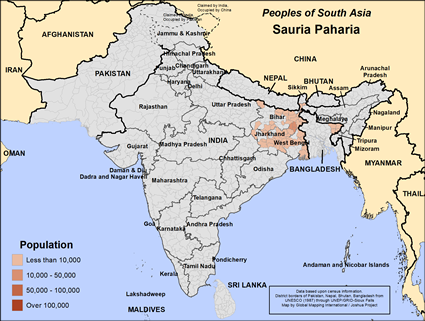Sauria Paharia in India

Send Joshua Project a photo
of this people group. |

Map Source:
People Group data: Omid. Map geography: UNESCO / GMI. Map Design: Joshua Project.
|
| People Name: | Sauria Paharia |
| Country: | India |
| 10/40 Window: | Yes |
| Population: | 52,000 |
| World Population: | 60,400 |
| Primary Language: | Mal Paharia |
| Primary Religion: | Hinduism |
| Christian Adherents: | 47.41 % |
| Evangelicals: | 0.00 % |
| Scripture: | Complete Bible |
| Ministry Resources: | No |
| Jesus Film: | Yes |
| Audio Recordings: | Yes |
| People Cluster: | South Asia Tribal - other |
| Affinity Bloc: | South Asian Peoples |
| Progress Level: |
|
Introduction / History
The Sauria Paharia are one of the many Hindu ethnic groups in India, primarily found in the northern state of Himachal Pradesh. This rugged mountain region features roads that are often mule tracks or footpaths, winding around the outer slopes of the Himalayas.
What Are Their Lives Like?
The Sauria Paharia are a hardworking and often isolated people. Many of their villages are snowbound for up to four months a year, and the people must live on what they have stored away. Most of the Sauria Pahari are farmers. They cultivate terraces on hillsides which produce only sparse crops twice a year. Their principal crops are potatoes and rice, and a variety of other vegetables are also grown. They use fertilizer and a system of plot rotation in which portions of the ground are allowed to lie fallow. They grow wet rice during the monsoon season and dry rice, maize, millet, and wheat on the drier land during the summer and winter months. Most of the farmers raise buffalo and goats for meat and cows for milk. The villagers live on a simple diet of milk, lentils, a few vegetables, a little fruit and occasionally meat.
The Sauria live in extended families within villages composed of loosely arranged homes surrounded by farmland. These villages are usually situated near rivers or springs, and the homes are linked by footpaths. Occasionally, these paths converge near a large tree that serves as a meeting spot for villagers and a resting place for travelers.
The houses are rectangular, featuring stone and mortar walls. They create their roofs from slate, wood, or thatch. Doors, windows, and door frames are often intricately carved and painted. Typically, the houses have two or more stories, with people living on the second floor while animals roam freely on the ground floor.
During religious festivals or village fairs, the women like to wear brightly colored clothes, heavy silver nose rings and earrings and colorful head scarves.
There are various rites of passage for children, such as their first rice feeding and first haircut. Additionally, girls experience puberty rites while boys undergo initiations known as sacred thread ceremonies. Around the age of eight, children start taking on domestic chores. Girls look after younger siblings, fetch water and provide food for the animals. Boys tend to the animals, assist in the fields or deliver milk to the market. Many children walk up to five or six miles daily to get to school.
What Are Their Beliefs?
The vast majority of the Sauria Pahari are Hindus, and nearly all of the others practice ethnic religions. Those who are Hindus are generally not as strict in their observance of religious laws as other Hindus. They worship village and household gods, including ancestral spirits, ghosts, demons and fairies. The Sauria also recognize the five Pandava brothers (heroic warriors of a Hindu epic) as deities, although other Hindus do not.
Prayer Points
Ask the Lord to call people who are willing to share the ways of Christ with the Sauria Pahari.
Ask God to give Sauria Christians boldness to disciple and love their own people, regardless of their caste system.
Records show there are more Christians in southern India than in the north, so ask God to send Indian Christians north to share the light and love of Jesus and God's truth with the Sauria Pahari.